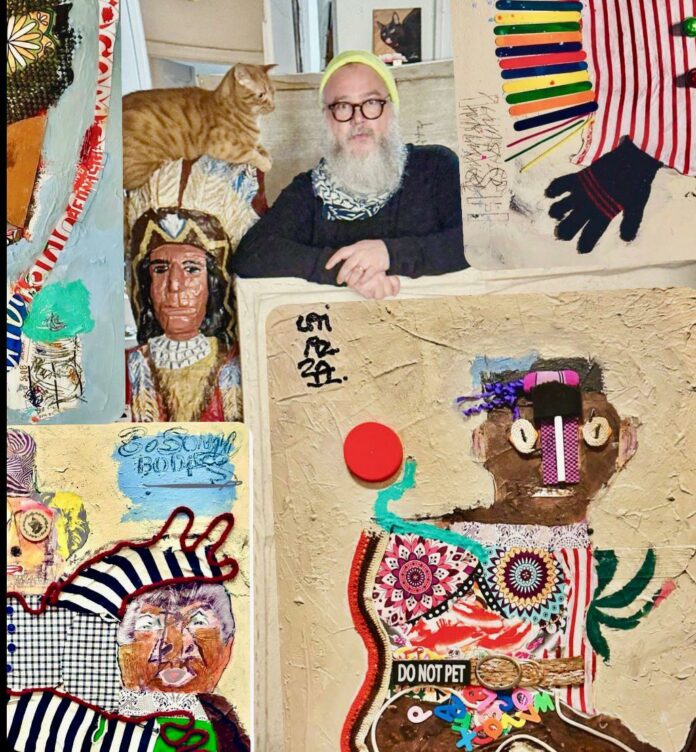Works by Alejandro Caiazza at the William V. Musto Cultural Center
Art is a powerful way of expressing the human condition.
Lucian Freud
José Gregorio Noroño
The William V. Musto Cultural Center, in Union City, New Jersey, is made up of an art museum, a history museum, an art gallery and a concert hall. On this occasion, the Musto has the honor of granting its prestigious gallery space for the first time to present a set of works of art by Alejandro Caiazza (1972), under the title of Mixed Repertoire, works belonging to different periods of his career, which have been exhibited in other spaces in the city of Manhattan, made with different procedures such as collage, for example, where Caiazza incorporates some materials such as cardboard and textiles, which accentuate the texture of his compositions, which become his most recent works; That is to say, these technical processes, applied in his previous works, are expanded and made more perceptible in his current proposals with a more experimental purpose, enhancing in the spectator a richer visual experience, compositions that the public will have the opportunity to see, in due time, in the spaces of the Van Der Plas Gallery (NYC).
This Venezuelan artist has lived in New York for 14 years, a city where he has developed his work, which he has exhibited in collective and individual events in different cities of America, Europe and Asia. It is appropriate to mention his most recent exhibitions, such as: “Graffiti & Street Art”, Museum of Contemporary Art Cleveland (Rayburn Gallery); Julia De Burgos Cultural Art Center (Cleveland, Ohio); “Earth to Sky & the Human condition”, Van Der Plas Gallery (NYC); “4 Artists”, Winston Scott Gallery (Warwick NY); “1000 Faces”, The Silos at Sawyer Yards, Gallery 200 (Houston, Texas); “Collective Collection” Galerie Satellite (Paris, France).
Caiazza’s artistic production – with his own stamp, without limitations, of free and experimental visual expression – does not only consist of a repertoire of mixed technical procedures, but also of different styles, but related and merged by the artist, such as primitivism, marginal art, art brut, bad painting, neo-expressionism and some pop art, whose color palette is characterized by being explosive, with brushstrokes with accentuated gestures, wide stains and drips that he combines with irregular and thick lines and contours, in some cases, as well as accentuated textures achieved with pictorial and extra-pictorial resources. The human figure – animal or hybrid, at times – is a recurring motif in Caiazza’s work, conceiving it in a grotesque way, emphasizing physical deformity and the darkest and most absurd aspects of morality, with a great deal of humor and irony, to the point of being caricatured, as a way of openly draining his emotions and feelings from his inner self.
The grotesque, the caricatured and irony are aesthetic categories that contemporary art uses to challenge traditional narratives – values, beliefs and social customs – to explore, question and reflect on the human condition, on existence in such a disturbed and dehumanized world. Artists like Caiazza make use of these resources of contemporary aesthetics to criticize aspects of society, politics and culture, thus showing their false, absurd and destructive actions. The grotesque, the caricatured and the ironic can generate different reactions in the viewer: laughter, pleasure, disgust, disturbance, horror, suspicion or reflection. Through these aesthetic resources with which Caiazza develops his visual discourse, he makes the viewer an accomplice, inviting him to interpret, reflect and question his own thoughts, beliefs, attitudes and behaviors that affect his peers, his sociocultural, individual and natural environment.
In short, as I have always thought, art is not only creation and contemplation; art goes beyond mere virtuosity; it transcends the beautiful and decorative to disturb us and make us reflect, a component that induces us to weigh up and act to transform our inner and outer reality. I conclude, then, that Alejandro Caiazza’s aesthetic intention is based on this idea.







